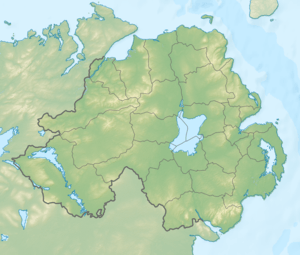1970 RUC booby-trap bombing
| 1970 RUC booby-trap bombing | |
|---|---|
| Part of the Troubles | |
 | |
| Location |
Crossmaglen, County Armagh, Northern Ireland |
| Coordinates | 54°7′55.72″N 6°34′57.10″W / 54.1321444°N 6.5825278°WCoordinates: 54°7′55.72″N 6°34′57.10″W / 54.1321444°N 6.5825278°W |
| Date |
11 August 1970 12:30 a.m. |
| Target | Royal Ulster Constabulary personnel |
Attack type | booby-traped car bomb |
| Deaths | 2 RUC Officers |
Non-fatal injuries | 0 |
| Perpetrator |
Provisional IRA South Armagh Brigade |
The 1970 RUC booby-trap bombing was an incident that took place in South County Armagh on the 11 August 1970 where two Royal Ulster Constabulary (RUC) officers were killed in an explosion when they accidentally triggered a booby trap bomb planted under a car by the IRA near Crossmaglen, County Armagh. These were the first RUC officers to be killed by the Provisional IRA (PIRA) and the first security forces to be killed in South Armagh, an IRA stronghold for much of the Troubles.
Background
The Troubles had started a year earlier in August 1969 with the Battle of the Bogside followed by the August 1969 riots where loyalists had gone on the rampage burning hundreds of Catholics from their homes in Belfast and shooting several dead. Soon after the British Army was called in order to restore the peace.
Initially relations between the British Army and the local Nationalist community was good but relations soon soured after the Lower Falls Curfew of July 1970 during which the Army shot dead four Catholic civilians and looted peoples homes in the curfew area. This was a turning point in the conflict as it turned most Nationalists against the British Army when at first they saw the Army as a neutral force in the conflict.
Soon after the Falls Curfew there was regular confrontations between the Army and the local population and rioting in Nationalist areas. People in places in South Armagh like Crossmaglen, Cullyhanna and Forkhill hated the British Army and viewed them as an occupying army who were disrupting their daily lives, harassing people and communties, and they were strongly Republican areas and their symphathies lay with the IRA without question.
The Bombing
The bombing occurred when an IRA booby-trap bomb attached to an abandoned Ford Cortina near Crossmaglen, South Armagh was found by the two RUC officers. The bomb contained 20 lb (9.1 kg) of gelignite and exploded when one of the officers attempted to open one of the car's doors seriously injuring the two officers (Samuel Donaldson, 23 and Robert Millar, 26) who both died the next day. These were the first security forces to be killed during the conflict between 1970 - 1998.[1][2][3] The car had been stolen outside Ardmore Hotel in Newry on 7 August. The action was planned and executed by an active service unit made up of IRA members from Navan, County Meath and Inniskeen, County Monaghan, both in the Republic of Ireland. The group was led by high-profile republican Seán Mac Stiofáin.[4]
Aftermath
Another member of the British security forces wasn't killed again by the PIRA until the next year when in February 1971 the PIRA shot and killed Gunner Robert Curtis in Belfast. Curtis was the first British soldier to die during the Northern Ireland conflict.[5] After internment without trial was introduced in August 1971 violence rose to heights not seen in Ireland since the Irish Civil War of the early 1920s, with British Army and RUC patrols being attacked on a regular basis in Belfast & Derry city.[6][7]
See also
References
- ↑ http://cain.ulst.ac.uk/cgi-bin/dyndeaths.pl?querytype=date&day=11&month=08&year=1970
- ↑ McKittrick, David; Seamus Kelters; Brian Feeney; Chris Thronton (2000). Lost Lives. Mainstream Publishing. ISBN 1-84018-227-X.
- ↑ http://cain.ulst.ac.uk/sutton/chron/1970.html
- ↑ Harnden, Toby (1999). Bandit Country. The IRA & South Armagh. Coronet Books. p. 56. ISBN 0340717378.
- ↑ http://cain.ulst.ac.uk/cgi-bin/dyndeaths.pl?querytype=date&day=6&month=02&year=1971
- ↑ http://cain.ulst.ac.uk/events/intern/intern.htm
- ↑ cain.ulst.ac.uk/othelem/chron/ch71.htm